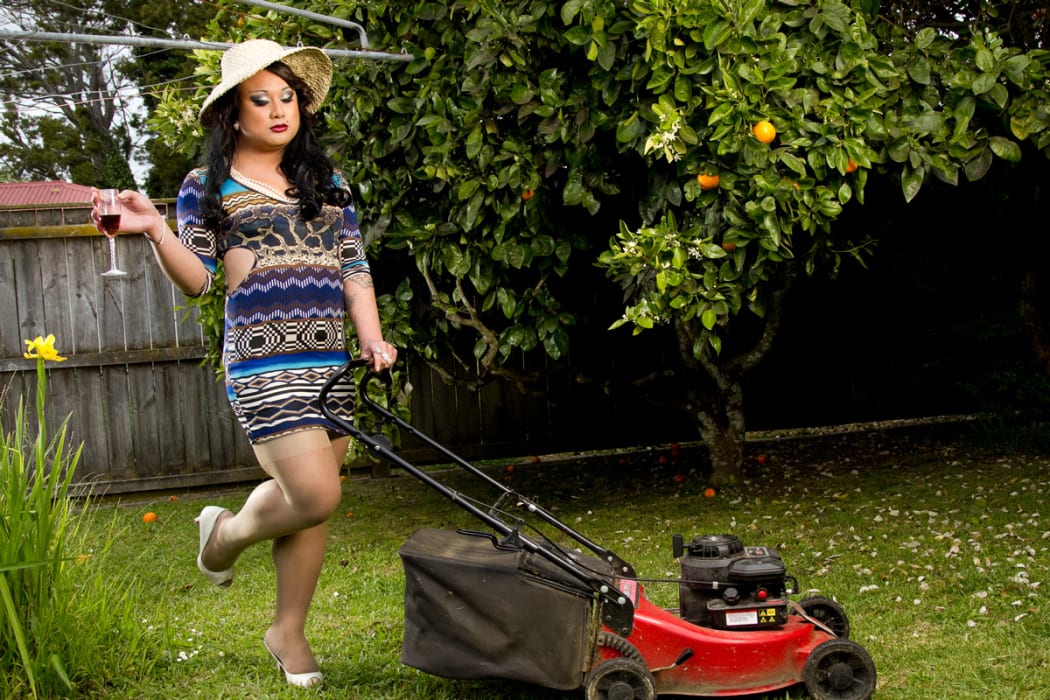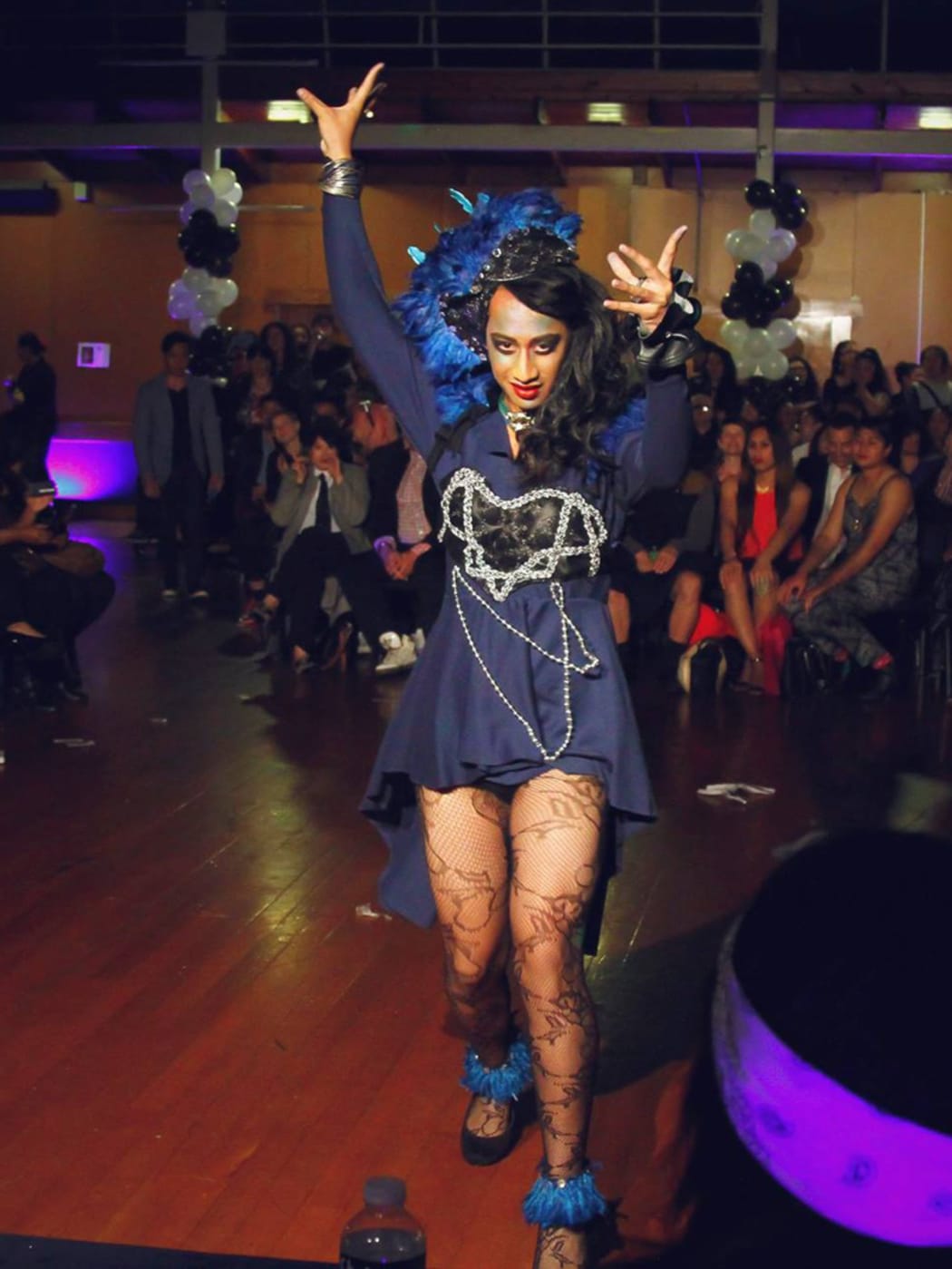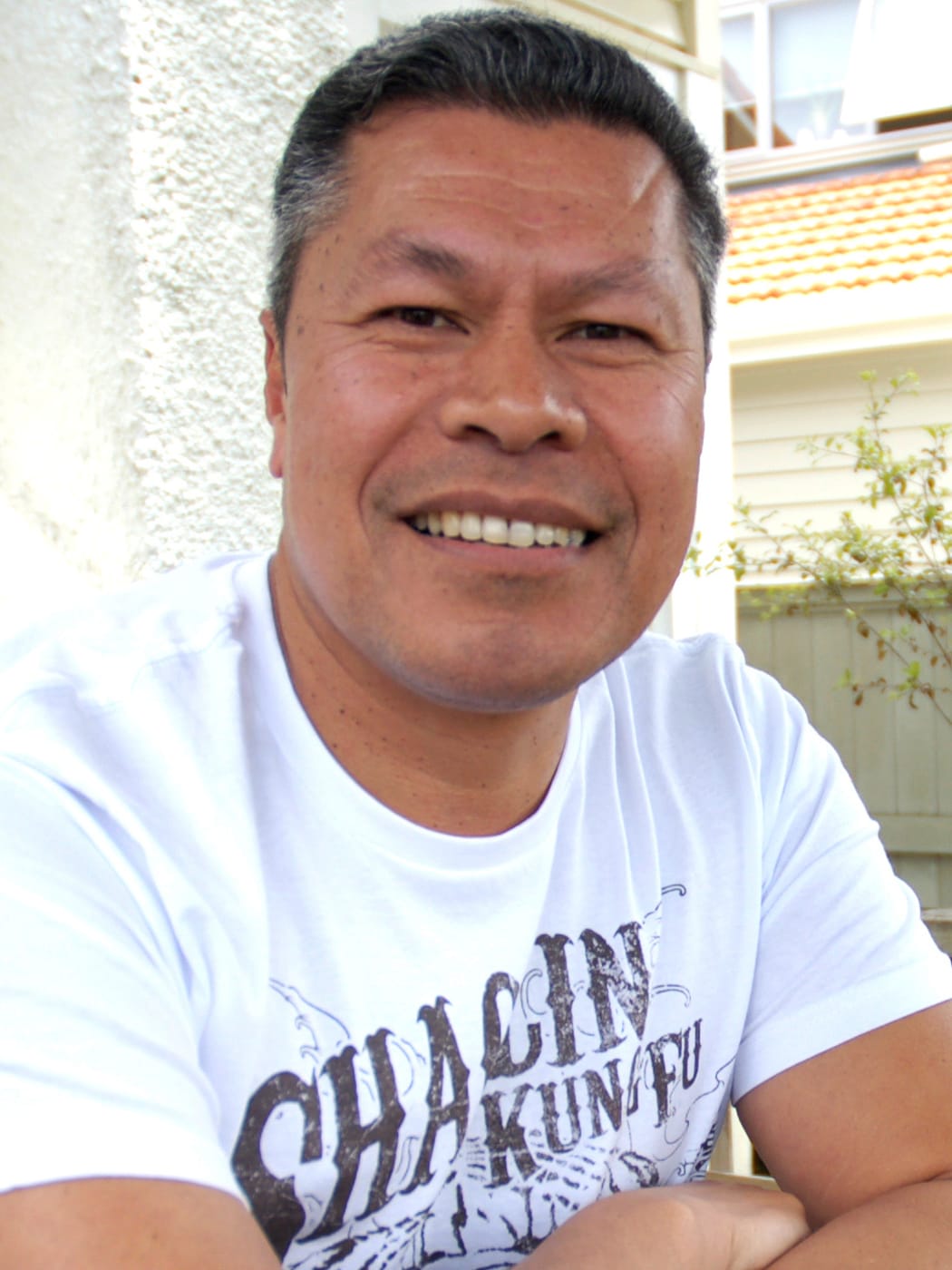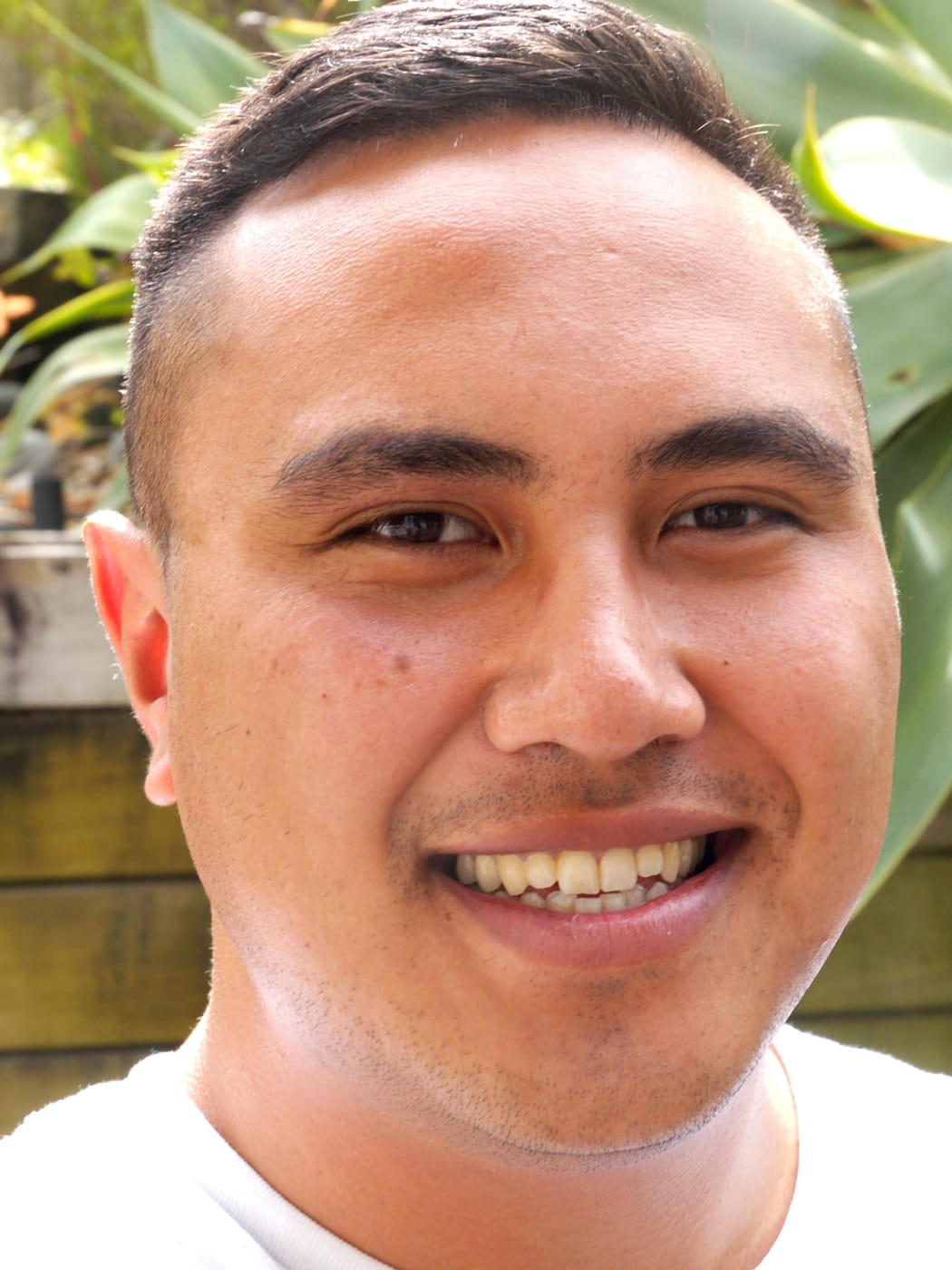Queer culture and religion don't often easily coexist, but a group in South Auckland is challenging stereotypes.

Artist Moe Laga challenges gender stereotypes. Photo: Moe Laga
Moe Laga sits in a chair and lets others do the work for once. Her hair is straightened, lips rouged, and foundation applied to her cheeks to cover her beard and adam’s apple.
Normally, the 23-year-old does it all herself for an hour, every morning. But this evening is all about looking her best - she’ll be setting the bar for dozens of Fafswag Ball contestants.
There are no mirrors in the kitchen where Moe is being beautified. The walls are stained and perfume bottles line the stove tops alongside cooking pots and dishes. It’s the main thoroughfare and there’s a constant clacking of size 11 heels on tiles as Moe’s eyelashes are glued on.
Putting on makeup wasn’t always so easy.
After she finished high school, Moe grew her hair out and was a “hot tranny mess” before she found her own style but she says there are still days when she’s not sure she’s got it right.
“I feel like I’m constantly being judged on an everyday basis. It’s really hard in the mornings trying to figure out what to wear and [wondering] ‘do I look like a legit female?’ Sometimes I’ll go to my young nieces and nephews because kids always tell the truth, and I’ll be like ‘do I look like a man today?’ and they’ll be like ‘yes, you do Aunty’, ok more makeup.”
LISTEN to Daniela Maoate-Cox's audio documentary Gays In Leis:
But the Fafswag ball in South Auckland’s Otara is an evening celebrating identity in all shapes and forms. It’s a Polynesian take on the competitive ball culture from New York in which people form and join houses to compete in various gender bending categories.
Near Moe, a contestant for the Poly-Typical category stands draped in metallic green. A belt and collar woven out of natural fibre acknowledge her Pacific heritage, while across the room, contenders for the Butch Queen category button up plaid shirts. This year seven different houses of Pacific lesbian, gay, bisexual, transgender, queer and intersex (or LGBTQI for short) people are twisting the binaries of gender through costume, dance and attitude to impress the judges.

Fafswag contestant Isha. Photo: Supplied
It’s a far cry from the popular portrayal of Pacific people in the media, which often paints them as a conservative group sharing one opinion. In recent years the hot topic has been marriage equality and as a predominantly religious group, Pacific people have often been lumped together with the churches in opposition to the bill.
But not everyone agrees.
In Fresh Gallery Otara the Poly-Typical category is reimagined as a Maori and Polynesian LGBTQI exhibition sharing the same name and curated by the ball’s organiser, Tanu Gago.
While the various photographs, videos and sculptures relate to the individual artists, Tanu says the glue that holds the exhibition together is the idea of being an orator for a new generation who don’t always subscribe with the stereotypes applied to Polynesian people.
Moe Laga is one of those artists and Tanu says her art speaks to a broader community.
“In this portrait series, she’s decided to talk about the masculine roles that are predominantly assigned to her as a person and how she prefers to do them,” he said. “She still has to mow the lawn and I’m sure if it was up to her she would prefer to do the lawn in that incredible dress and those pearls.”
Across the road from the exhibition is a Samoan Methodist Church but Tanu can’t imagine a situation where the two spaces, and the ideologies they represent, would clash.
“I love that the churches are around this space because that’s just real life,” he said. “Our young people are embedded in religious frameworks, it’s part of their culture and their identity and just because they identify this way doesn’t mean they’ve abandoned those values. It’s still very much a part of their life and I feel that’s reflected in the landscape, these two things coexist geographically the same way they do within our young people.”
Some of those young people have come across the path of the University of Auckland’s chaplain Uesifili Unasa who supported the marriage amendment bill. In the time he’s been a minister, Uesifili has supported both those that may be LGBTQI identifying and those that reject all but heterosexuality. Uesifili doesn’t think his stance is radical.

Uesifili Unasa Photo: Daniela Maoate-Cox/The Wireless
“Nothing’s more natural in my view than our sexuality. Our Pacific people, when you give them the time of day, would be really comfortable to articulate the same things that I’m saying to you now. A lot of the views that we hear, the loudest voices that speak, tend to be more about the agenda of those who allow those voices and those views to be heard.”
While most people in South Auckland are spending their Sunday in church, Usufonoimanū Peseta Betty Siō is in the office. She’s among those working to help Pacific people articulate their opinions through the anti-violence organisation The Project. Homophobia is a form of violence ,she says and The Project does a lot of work with young LGBTQI people.
“During the marriage equality bill, some young people came out saying that they were being forced to sign a petition to say that they were against the bill and most of them decided not to sign it. They felt pressured, just from their own people, and within the churches.”
While Pacific people were seen speaking out against the bill Betty says the opposition was a religious view, and not specific to ethnicity or age.
“We get to have conversations, and it’s getting people to talk, to understand who they are in that space, whether you’re straight or LGBTQI, it shouldn’t matter. You should be able to have a conversation about who you are and be OK with it. That’s why we’re here.”
One person who has taken that journey of self discovery is Tele’a Andrews. A self-proclaimed product of Catholic schooling in Wellington, Tele’a once thought he would become a minister. But at the age of 19 he moved to Auckland on a scholarship to study and once away from the distractions of family and religious obligations, Tele’a came out as gay.

Tele'a Andrews Photo: Daniela Maoate-Cox/The Wireless
“It was actually quite a rude awakening to me and I got very panicked and worried about what that meant for the rest of my life. When I looked at my life and the idea that I was going to enter a religious life I thought ‘how could the two coexist?’’.”
Tele’a was on the verge of giving up his faith but a chance meeting with a Father from his hometown changed his mind.
“He just told me a story about his cousin who came out as gay. He told me basically he still loves his cousin and his cousin is a huge part of his life and he said to me, which always lasted with me, that God calls everybody by name, and you can’t escape God’s call and whatever you do in life, you will be a minister to people. That’s why I’ve always believed in this walk, that my faith has pulled me out of the shadows.”
While church and faith go hand in hand a lot of the time Tele’a believes people can still be filled with the holy spirit without sitting in a pew every Sunday.
“There are a lot of people out there with a deep-seated faith in God and what they’re called to do. They might not be at church every Sunday but they’re out there living church. They’re the people holding hope for people who find it difficult to hold it themselves and if that’s not the church made manifest then I’m not too sure what is.”
Back in the kitchen, Moe’s transformation into the “mistress of mayhem” is complete but she admits her mayhem is kept in check by her religious upbringing.
“Church every Sunday, Sunday School,” she sighs at her reflection in a mirror.
“I have to say having that whole religious upbringing has kept me grounded as a person. I still have my mother’s voice in my head. The ‘get up for church!’ and I’m like ‘I’m hungover’, she giggles.
The journey hasn’t been easy and spaces like Poly-Typical and the Fafswag ball are a positive sign that attitudes are changing.
“You don’t see works being done by our LGBT community all in one gallery. It’s not typical,” says Moe.
“But it’s a good thing.”


